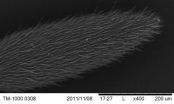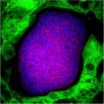(Press-News.org) GAINESVILLE, Fla. -- A study by University of Florida and University of Kansas researchers describing eight new cusk-eel species provides data for better understanding how disasters like the 2010 Gulf of Mexico oil spill impact biodiversity and the environment.
The 60-year study appearing Tuesday in the Florida Museum of Natural History Bulletin provides a comprehensive taxonomic revision of one of the least-studied groups of cusk-eels, bony fishes distantly related to cod. Although abundant and widespread in the Americas, the fishes in the genus Lepophidium have previously been poorly known to biologists.
"With the recent Gulf of Mexico disaster, one of the first things that people started asking was what impact was had and on what animals, and a lot of biologists said, 'We don't know all the animals that are in the Gulf of Mexico because the area hasn't been studied enough,' " said study co-author Rob Robins, ichthyology collection manager at the Florida Museum of Natural History on the UF campus. "A number of these species are from the Gulf of Mexico, including some of the new ones, and this paper brings us closer to our ultimate goal of cataloguing the diversity of life so that when we need the information, it's available."
In addition to describing the new species, the study includes new descriptions of all members of the genus and elevates two sub-species to species, bringing the number of Lepophidium species to 23. The research included observations of the fish in the wild, X-rays of their internal anatomy and close examination of thousands of museum specimens.
Lead author C. Richard "Dick" Robins, University of Kansas curator emeritus, completed much of the fieldwork and collected many examples of cusk-eels as a professor of marine science at the University of Miami. Miami's fish collection was later transferred and is now part of the Florida Museum's ichthyology collection, one of the five largest in the nation.
"I think it's amazing that there is a group of fishes that is really common in shallow water that had so many undescribed species," Dick Robins said. "It just shows the state of the art is really poor and unfortunately, I think it's really typical. I'd hate to hazard a guess about how many undescribed species of fish there are in really shallow waters, but people don't seem to work on them that much."
The genus Lepophidium includes smaller species of cusk-eels that live on the Continental Shelf, from shallow coastal water to about 600 feet deep.
"Since these are soft-bottom fishes and some of these occur in shallow waters, you're dealing with man's effect on the environment, what pollution does to some of these environments and how it affects the animals that live there," said California Academy of Sciences research associate Robert Lea, a marine biologist who specializes in another genus of cusk-eels. "Some of these are going to be Gulf of Mexico species and probably many of these are going to be indicators of environmental quality also."
Because they are benthic, meaning they live near the bottom, and burrow in sand, cusk-eels are particularly difficult to collect, Lea said.
"This is a group that we've needed additional knowledge on, and this study provides a tremendous amount of information for people studying soft-bottom fishes in the Americas," Lea said. "This is a milestone work because it's a lifelong study and it answers a lot of questions. It's the end of a chapter for that group of animals."
Cusk-eels are plainly colored, typically with a beige body and some degree of black pigment in the fins. They also have a rostral spine, a sharp point found on their snout. Major differences in the cusk-eels include features of their internal anatomy, such as number of vertebrae or gut color. Fin ray counts are also important for distinguishing the various species.
"This is not a case of just working with specimens in a museum – it's important to know these animals and where they live," Dick Robins said. "I think it's important that we know about the animals that we share this planet with."
Cusk-eels may reach 6.5 feet in South America, where they are an important food source in some regions, but the Lepophidium species, which do not exceed 1 foot, are generally too small for human consumption, researchers said. Dick Robins became interested in studying cusk-eels in the early 1960s because he encountered so many undescribed species, he said.
"This was a group of fish that turned me on at some point and nobody else was working on them," Dick Robins said. "The more I worked, the more undescribed species I found. So I just got more and more involved with it. I'm very happy to have this opportunity to bring it all together in this paper."
Florida Museum volunteer Mary Brown is also a study co-author.
###
Credits
Writer
Danielle Torrent, dtorrent@flmnh.ufl.edu
Source
Rob Robins, rhrobins@flmnh.ufl.edu, 352-273-1957
New Rochelle, NY, September 10, 2012-- Therapies for retinal diseases are expected to overtake those for glaucoma by 2014, reports Genetic Engineering & Biotechnology News (GEN). Because current retinal disease treatments only improve vision for six to eight weeks, there is a critical need for new remedies, according to a recent issue of GEN.
"As increasing numbers of baby-boomers continue to grow older, many will have to deal with eye diseases such as age-related macular degeneration," said John Sterling, Editor-in-Chief of GEN. "Some estimates put the current AMD and ...
NEW YORK (September 10, 2012) -- An off-patent anti-inflammatory drug that costs around two cents for a daily dose in developing countries has been found by researchers at Weill Cornell Medical College to kill both replicating and non-replicating drug resistant tuberculosis in the laboratory -- a feat few currently approved TB drugs can do, and resistance to those is spreading.
Their findings, published online by the journal PNAS, point to a potential new therapy for the more than 500,000 people worldwide whose TB has become resistant to standard drug treatments. But ...
PROVIDENCE, R.I. – The next time you call someone a drunken pig, remember this study. Rhode Island Hospital researcher Frank Sellke, M.D., chief of cardiothoracic surgery at Rhode Island and The Miriam hospitals, and his colleagues studied the effects of red wine and vodka on pigs with high cholesterol and found that the pigs with a penchant for pinot noir fared better than their vodka swilling swine counterparts. The paper is published in the September issue of the journal Circulation.
"There has been previous research touting the benefits of moderate consumption of ...
Ants have four to five times more odor receptors than most other insects, a team of researchers have discovered.
The research team, led by Lawrence Zwiebel at Vanderbilt, recently completed the first full map of olfactory system that provides ants with their sense of taste and smell. They found the industrious insects have genes that make about 400 distinct odorant receptors, special proteins that detect different odors. By comparison, silk moths have 52, fruit flies have 61, mosquitoes range from 74 to 158 and honeybees have 174.
"The most exciting moment for me was ...
This press release is available in Portuguese.
ANN ARBOR, Mich. — Two different genetic mutations cooperate to induce adrenal cancer, according to a new study from researchers at the University of Michigan Comprehensive Cancer Center and University of Sao Paulo in Brazil.
The finding provides new clues to this rare and deadly cancer type, and researchers hope it will lead to better treatments by targeting both mutations.
About 600 Americans are diagnosed with adrenal cancer per year. It is typically diagnosed in late stages when there is nearly no chance of survival ...
According to AARP, the annual cost of unpaid elder caregiving – work that falls mainly on the backs of family members – runs about $450 billion.
While some companies document the physical and emotional toll that the workplace takes on their employees, exactly how draining caregiving might be has never really been measured.
So Case Western Reserve University nurse researchers studied it.
"Without knowing the impact of effort, we have two vulnerable people at risk for health issues—the caregiver and the care receiver," said Evanne Juratovac, assistant professor at ...
EAST LANSING, Mich. -- People who commit cyber-attacks against the government also tend to download music illegally and participate in physical protests. Surprisingly, however, they don't appear to be acting out of some sense of national pride or patriotism.
Those are some of the findings to emerge from a Michigan State University study that for the first time begins to paint a profile of "civilian cyber-warriors," or people who engage in attacks against domestic or foreign governments. Cybercrimes pose a huge societal risk and have become a hot issue globally, yet little ...
Results of a new study tie forest "greenness" in the western United States to fluctuating year-to-year snowpack extent.
The results show that mid-elevation mountain ecosystems are the most sensitive to rising temperatures and to changes in precipitation and snowmelt.
University of Colorado-Boulder scientist Noah Molotch and colleagues used satellite images and ground measurements to identify the threshold at which mid-level forests sustained by moisture change to higher-elevation forests sustained by sunlight.
A paper reporting the results was published yesterday ...
Satellite images from two NASA satellites were combined to create a full picture of Tropical Storm Leslie and Hurricane Michael spinning in the Atlantic Ocean. Imagery from NASA's Aqua and Terra satellites showed Leslie now past Bermuda and Michael in the north central Atlantic, and Leslie is much larger than the smaller, more powerful Michael.
Images of each storm were taken by the Moderate Resolution Imaging Spectroradiometer, or MODIS instrument that flies onboard both the Aqua and Terra satellites. Both satellites captured images of both storms on Sept. 7 and Sept. ...
PORTLAND, Ore. — A novel human liver-chimeric mouse model developed at Oregon Health & Science University and Yecuris Corporation has made possible a research breakthrough at Seattle Biomedical Research Institute that will greatly accelerate studies of the most lethal forms of human malaria.
The study findings are published online in the Journal of Clinical Investigation. Study photos were selected to appear in "Scientific Show Stoppers" on the JCI blog.
Plasmodium falciparum, one of two human-specific malaria parasites, is a global health crisis, causing more than ...






